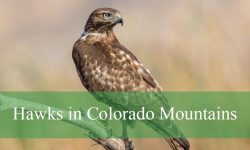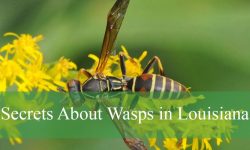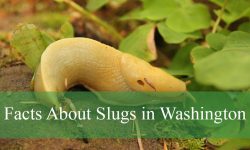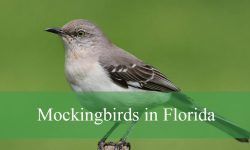Birds in Connecticut are incredibly diverse thanks to the state’s unique mix of coastal shores, forests, wetlands, and suburban areas. This variety of habitats supports many different species, making Connecticut a great place for birdwatchers and nature enthusiasts. Exploring coastal marshes or quiet woodlands reveals a wide range of bird species.
From colorful songbirds to large waterfowl and majestic birds of prey, the variety of Birds in Connecticut offers something for everyone. Many species migrate through the state seasonally, while others live here year-round. This dynamic bird population creates excellent opportunities for bird identification and photography.
In this article, you’ll find a detailed list of 50 Birds in Connecticut, complete with pictures and key identification tips. The birds are grouped into categories to help you recognize and learn more about the species commonly seen throughout the state’s diverse environments.
Backyard Birds in Connecticut
Black-capped Chickadee
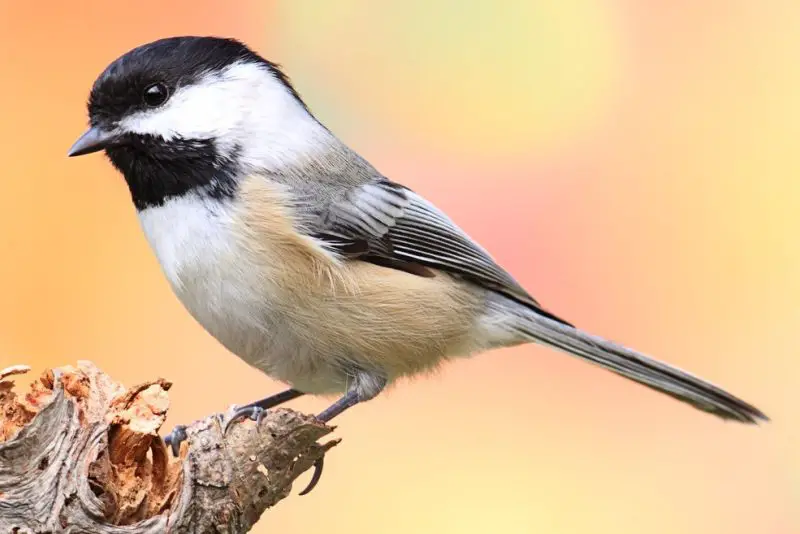
The Black-capped Chickadee is a small, round bird with a black cap and bib, white cheeks, and a soft gray back. Its flanks are tinged with buff or beige. Measuring only 4.5 to 6 inches in length with a wingspan of 6 to 8 inches, it is one of the smallest songbirds in Connecticut.
Its song is a clear, whistled “fee-bee” or “hey-sweetie,” while its namesake call sounds like “chick-a-dee-dee-dee.” The more “dees” at the end, the higher the alert level to danger. Chickadees are curious and bold, often approaching humans closely and memorizing feeder locations.
Black-capped Chickadees are year-round residents in Connecticut and favor deciduous and mixed woodlands, as well as backyard feeders. They are active foragers, flitting through trees and shrubs looking for insects and seeds. In winter, they often form small flocks with other bird species for safety and food sharing.
Mourning Dove
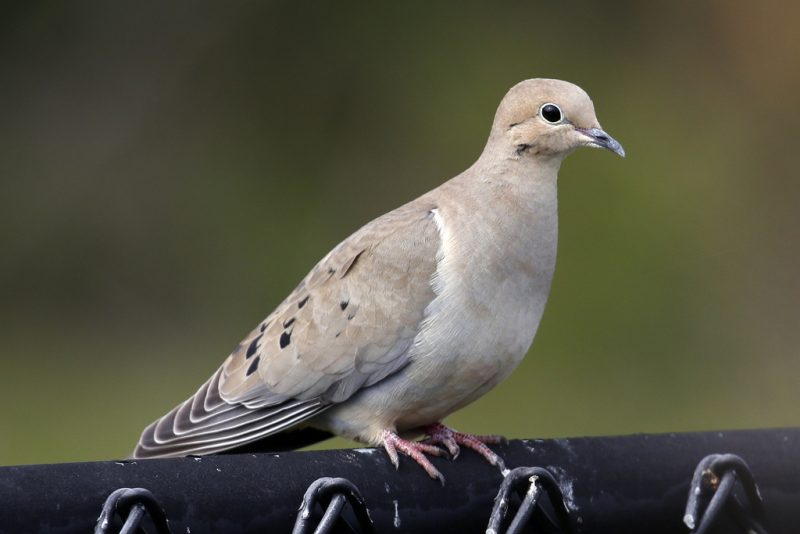
Mourning Doves are slender, medium-sized birds with soft gray-brown feathers, black spots on the wings, and a long, pointed tail. They have a small head and a quiet, gentle appearance. Adults typically measure about 9 to 13 inches long with a wingspan of 17 to 18 inches.
Their call is a soft, mournful cooing sound—“oo-woo-oo-oo-oo”—which gives them their name. Their wings make a sharp whistling noise when they take off, a sound that often startles predators. They are mostly silent and peaceful birds that spend a lot of time perched or feeding on the ground.
Mourning Doves are found throughout Connecticut in open habitats like fields, parks, and residential areas. They nest in trees, shrubs, or even on building ledges. These birds are year-round residents and are commonly seen foraging for seeds on the ground or resting on telephone wires.
Northern Cardinal
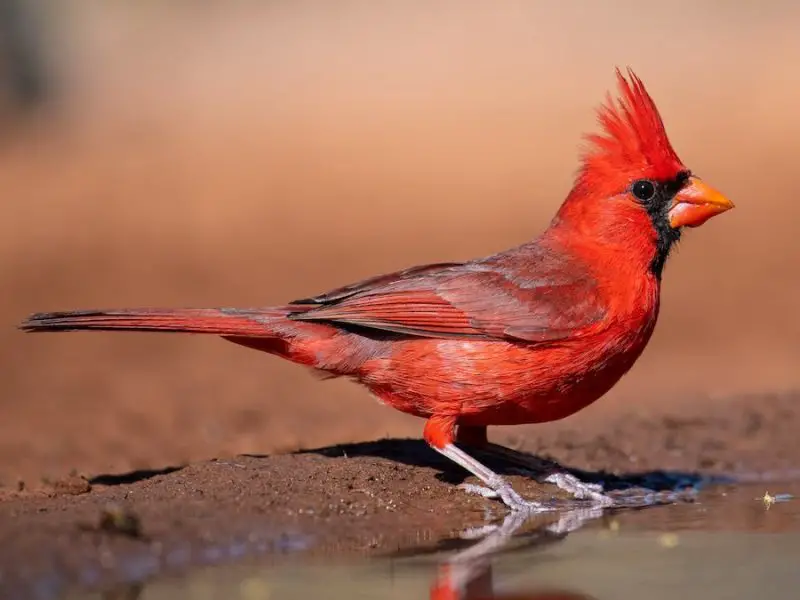
The Northern Cardinal is one of the most easily recognized birds in Connecticut due to its brilliant red plumage in males and warm brown tones with red highlights in females. Both sexes have a distinctive crest on top of their head and a thick, orange-red beak. They typically measure about 8 to 9 inches in length with a wingspan of around 10 to 12 inches.
Their call is a clear, whistling “cheer-cheer-cheer” or “birdy-birdy-birdy,” often repeated and heard throughout wooded neighborhoods and gardens. Cardinals sing year-round, and both males and females are vocal, especially during breeding season. They are also known for aggressively defending their territory, even attacking their own reflection.
Northern Cardinals are year-round residents in Connecticut. They thrive in suburban backyards, forest edges, and dense shrubs. They are frequent visitors to bird feeders, especially ones stocked with sunflower seeds, and are often spotted perched in trees or hopping on the ground in search of food.
American Robin
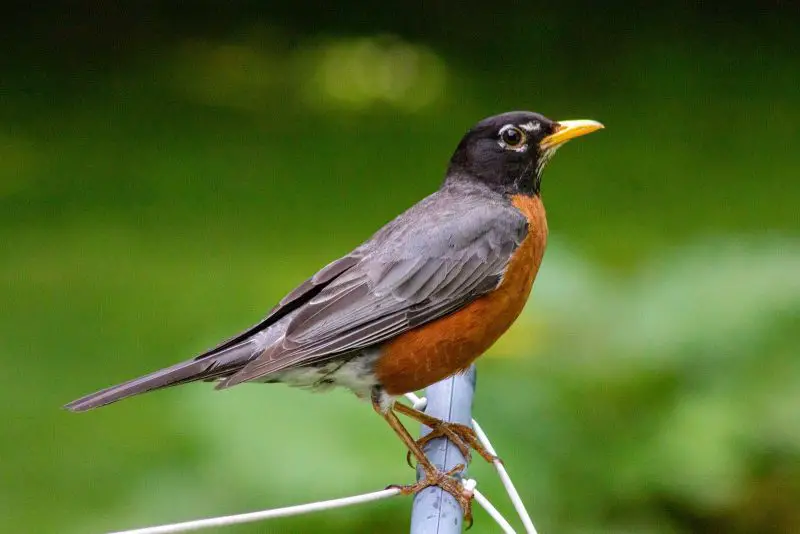
The American Robin is a familiar sight across Connecticut, especially during the spring and summer months. It has a grayish-brown back, a bright orange-red breast, and a white patch on the lower belly. Robins are medium-sized birds, about 9 to 11 inches in length with a wingspan of 12 to 16 inches.
Their song is a cheerful, rolling series of whistles, often heard in the early morning. They also make sharp “tut” or “yeep” sounds as warning calls. American Robins are among the first birds to sing at dawn and the last to fall silent at night, making them a common early sign of spring.
Robins are adaptable and can be found in a wide range of habitats in Connecticut, including yards, parks, woodlands, and fields. They are often seen running on lawns in search of earthworms, especially after rain. In the winter, many migrate south, but some flocks stay, feeding on berries and fruits.
Blue Jay
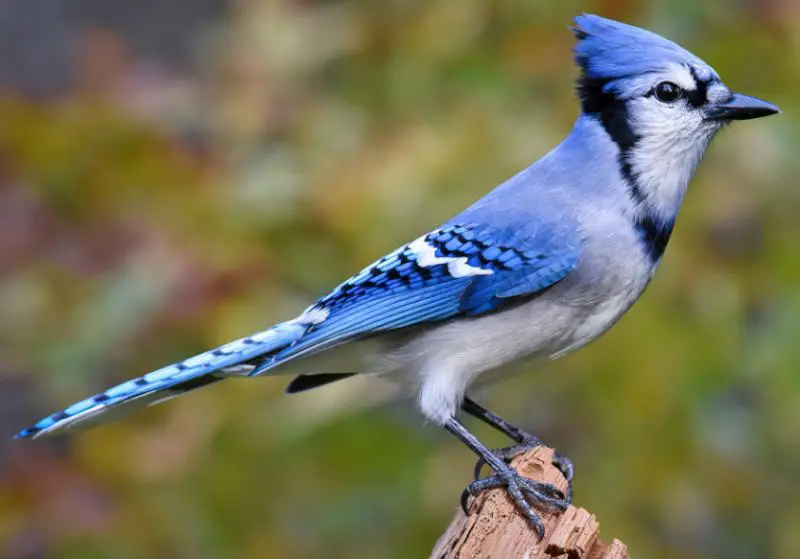
Blue Jays are striking birds with bright blue upperparts, white faces, and black markings around the neck that form a sort of collar. Their wings and tail are patterned with white and black, and they have a prominent crest. They are about 9 to 12 inches long with a wingspan of 13 to 17 inches.
Their vocalizations are varied and loud, including harsh “jay jay” calls, whistles, and even mimicking hawks. Blue Jays are known for their intelligence and complex social behaviors. They often cache food for later use and can be quite territorial and assertive at feeders.
Blue Jays are common throughout Connecticut’s forests, suburbs, and parks. They are year-round residents and often travel in family groups. They prefer oak-rich areas where acorns are abundant and are frequent visitors to feeders offering peanuts or sunflower seeds.
Tufted Titmouse
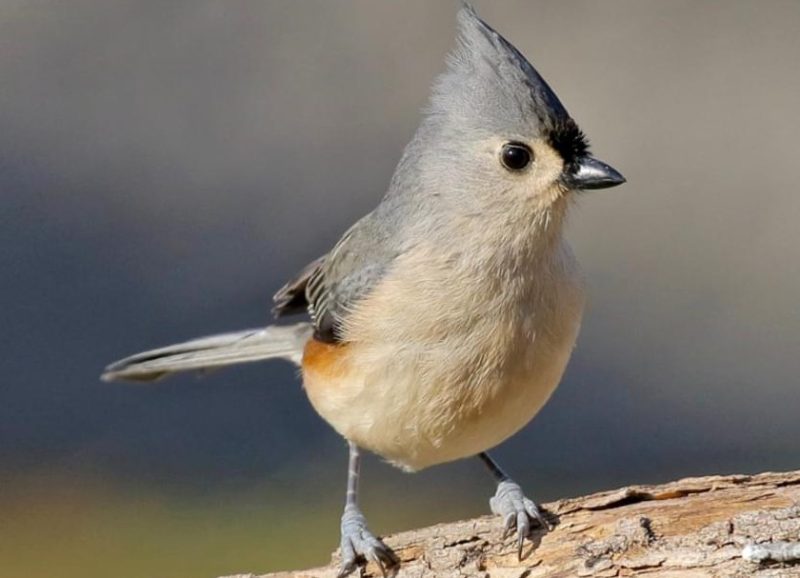
The Tufted Titmouse is a small, gray songbird with a prominent crest on its head, a white face, and a black patch just above the beak. It has soft peach-colored flanks and a compact, energetic body. Typically measuring about 5.5 to 6.3 inches in length, it has a wingspan of around 7.9 to 10.2 inches.
Its voice is clear and whistled, often sounding like “peter-peter-peter.” The Tufted Titmouse is vocal and curious, frequently calling out to its flockmates or warning others of predators. It’s known for its boldness at feeders, where it may snatch seeds and fly off quickly to eat them in cover.
This species is common year-round in Connecticut and prefers deciduous forests, woodlots, and suburban yards with mature trees. It frequently joins mixed flocks in winter and is often seen clinging to bark or hopping along branches in search of insects and seeds.
White-breasted Nuthatch
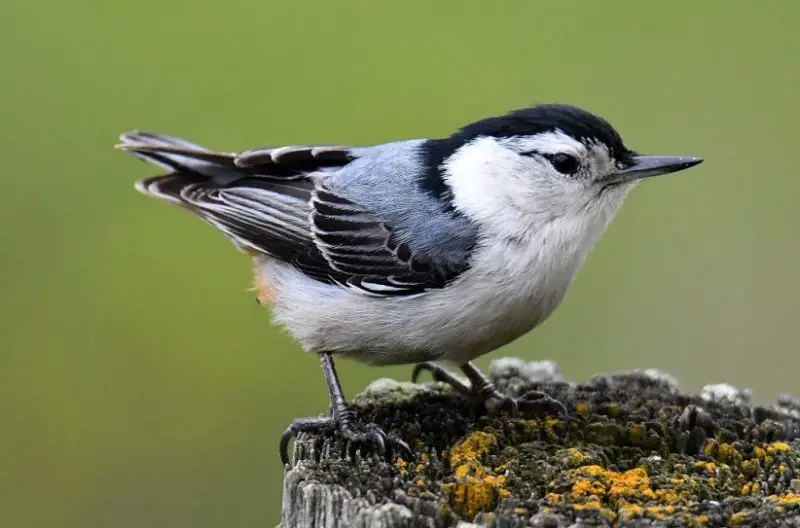
The White-breasted Nuthatch is a small bird with a clean white face and breast, a black cap, and a bluish-gray back. Its short tail and habit of climbing headfirst down tree trunks make it easy to recognize. It ranges from 5.1 to 5.5 inches in length with a wingspan of 7.9 to 10.6 inches.
Its call is a nasal “yank-yank,” which is loud and repeated, especially during territorial disputes. Nuthatches are agile and often seen moving in acrobatic patterns on tree bark as they probe for insects, nuts, and seeds. They often store food in crevices for later use.
White-breasted Nuthatches are found in Connecticut’s mature woodlands, especially those with oak and hickory trees. They are also common visitors to backyard feeders, where they prefer sunflower seeds and suet. These birds are non-migratory and remain active throughout the year.
Downy Woodpecker
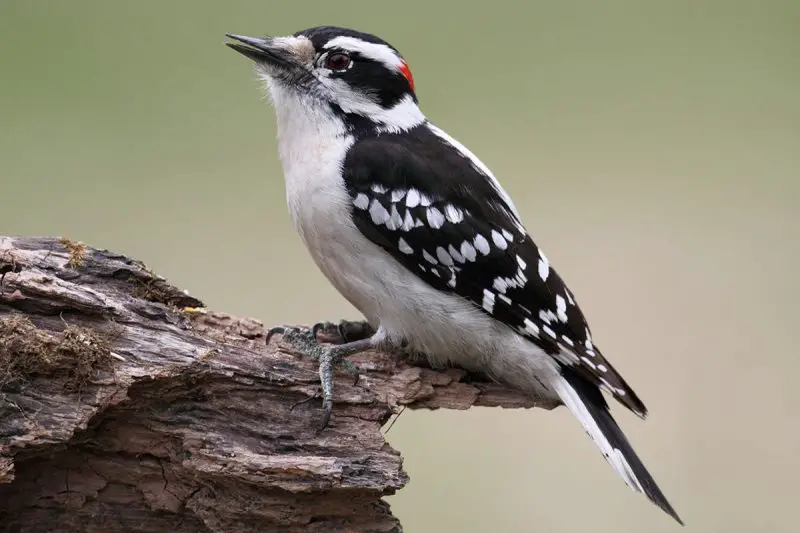
The Downy Woodpecker is the smallest woodpecker in Connecticut, with a length of 5.5 to 6.7 inches and a wingspan of 9.8 to 11.8 inches. It has a black-and-white striped head, a white back, and white underparts. Males have a small red patch on the back of the head.
Its call is a sharp “pik” sound, and it also produces a rapid drumming on tree trunks. Downy Woodpeckers use their small bills to tap into bark and retrieve insects, and they may also feed on berries and suet. They are calm, often allowing close observation.
These birds are common year-round across Connecticut, favoring forests, orchards, and suburban yards. They’re frequent at feeders, especially those with suet or peanut butter, and are usually seen clinging to tree branches or trunks, often alongside chickadees or titmice in mixed flocks.
House Finch
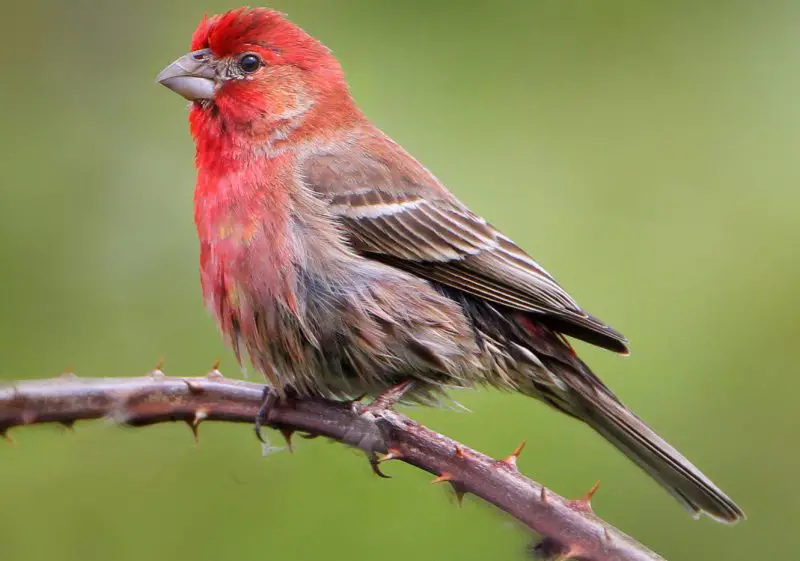
The House Finch is a small bird with a short, conical beak and a cheerful presence. Males have bright red plumage on the head, throat, and chest, while females are plain brown and streaky all over. They measure about 5 to 6 inches long with a wingspan of 8 to 10 inches.
Their song is a long, jumbled warble, often heard throughout the year. House Finches are highly social and are usually found in small flocks. They are adaptable and comfortable around humans, often nesting on buildings and feeding near homes.
In Connecticut, House Finches are widespread and thrive in urban areas, suburbs, and open woodlands. They are year-round residents and commonly visit feeders for sunflower seeds. They also eat fruits and buds, and may build nests in hanging planters, vents, or eaves.
American Goldfinch
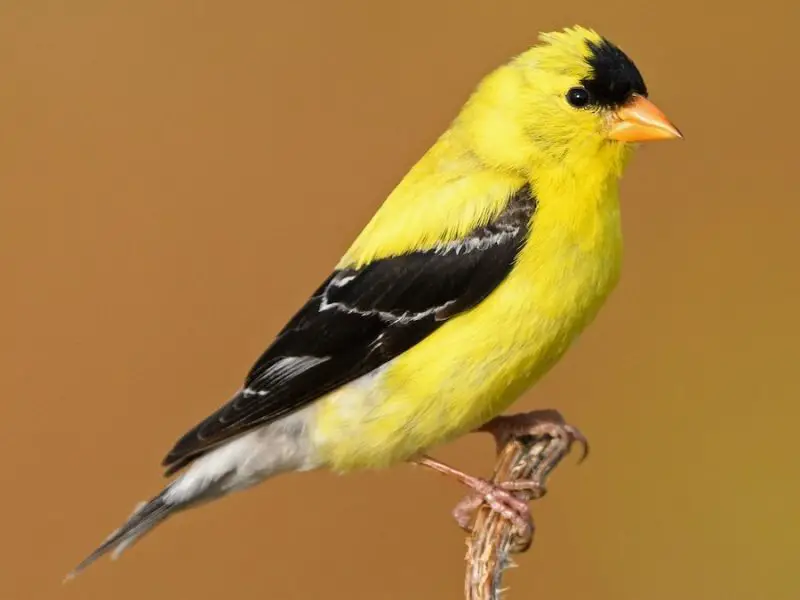
The American Goldfinch is a small, vibrant songbird well known for its bright yellow plumage in males during the summer and its contrasting black wings and cap. Females are more muted in color, with olive-brown tones. It measures about 4.3 to 5.1 inches long and has a wingspan of 7.5 to 8.7 inches.
Its song is a melodic series of twitters and whistles, and its flight call sounds like “per-chick-o-ree.” Goldfinches have an undulating flight pattern and often call while flying. They molt twice a year and are one of the last songbirds to breed, often waiting for thistle seeds to mature.
American Goldfinches are common across Connecticut and prefer open areas such as meadows, gardens, and roadsides. They are frequent visitors to feeders, especially those offering nyjer (thistle) seed. Though present year-round, they may migrate slightly south during colder months in search of food.
Water Birds & Shorebirds in Connecticut
Great Blue Heron
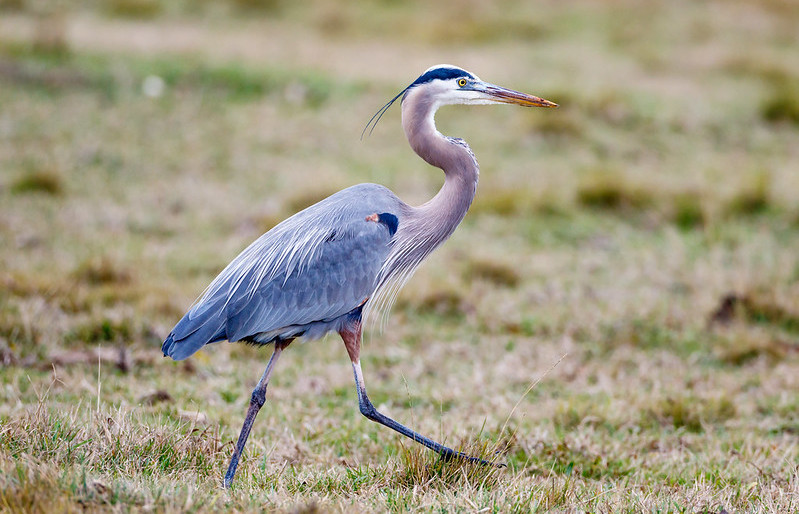
The Great Blue Heron is the largest wading bird in Connecticut, standing about 3 to 4.5 feet tall with a wingspan of up to 6.5 feet. It has a long neck, gray-blue plumage, a white face with a black stripe over the eye, and a dagger-like yellow bill. In flight, its neck folds into an S-shape and its long legs trail behind.
Its call is a deep, hoarse croak—often described as a “fraaank”—usually heard when the bird is startled or in flight. Great Blue Herons are solitary hunters, often standing motionless in shallow water as they wait to spear fish or amphibians with their sharp beaks.
In Connecticut, these herons are common in marshes, lakes, rivers, and estuaries from spring through fall, and some may remain during winter if water stays unfrozen. They nest in colonies called rookeries, usually in tall trees near water, and are often seen gliding silently over wetlands.
Double-crested Cormorant
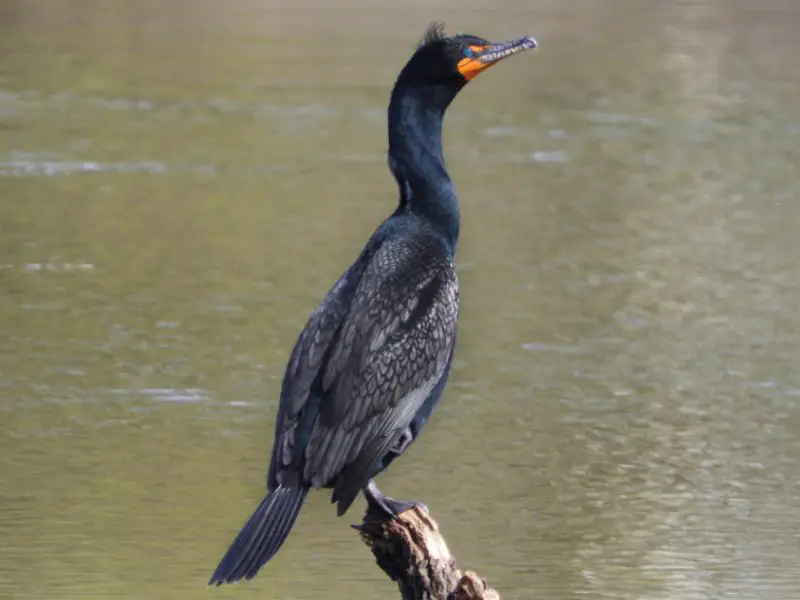
The Double-crested Cormorant is a large, dark waterbird with a slender body, long neck, and hooked orange-yellow bill. Adults are black with a slight greenish sheen and display two small tufts (crests) of feathers on their head during the breeding season. They measure about 28 to 35 inches long with a wingspan of up to 52 inches.
Their call is low and guttural, often a series of croaking or grunting sounds, though they are generally quiet. Cormorants are excellent divers and catch fish by swimming underwater. After feeding, they often perch with wings outstretched to dry, as their feathers are not fully waterproof.
These birds are commonly seen along the coast, rivers, and large inland lakes in Connecticut, especially during spring through fall migration. They nest in colonies on islands or in trees near water and are frequently spotted flying in straight lines or V-formations over open water.
Mute Swan

Mute Swans are large, elegant waterbirds with pure white plumage, a long neck, and a distinctive orange bill bordered with black. They are among the heaviest flying birds, weighing up to 25 pounds and measuring about 50 to 60 inches long with a wingspan of over 7 feet.
Despite their name, Mute Swans are not truly silent. They make hissing, snorting, and grunting sounds, especially when defending their territory or cygnets. They are territorial and can be aggressive toward other waterfowl, particularly during nesting season.
In Connecticut, Mute Swans are mostly found in ponds, lakes, estuaries, and slow-moving rivers. They are non-native and were introduced from Europe. Though beautiful, they are considered invasive in some areas due to their impact on native aquatic vegetation and wildlife.
Canada Goose
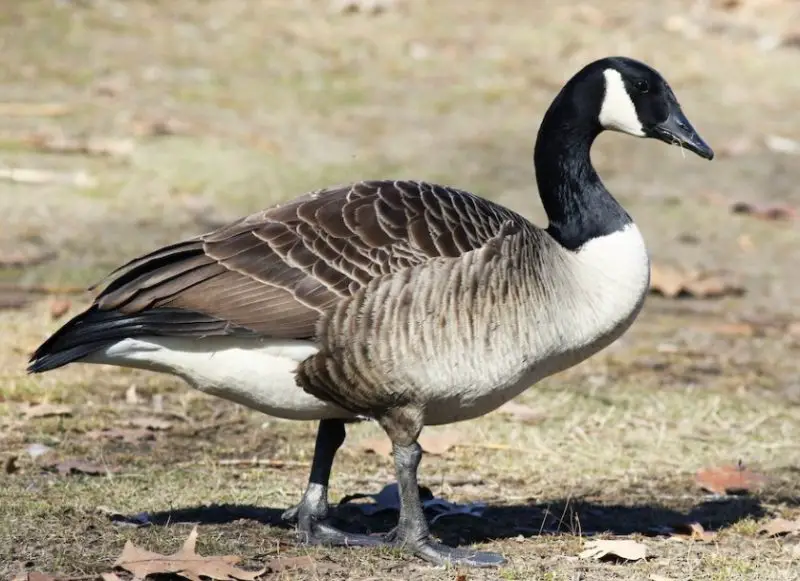
The Canada Goose is a large, familiar bird with a black head and neck, white chinstrap, and brownish-gray body. It measures between 30 to 43 inches in length with a wingspan that can reach up to 6 feet. Its strong, honking call is a common sound in Connecticut’s skies and wetlands.
Their honks are deep and resonant, often heard in V-shaped flocks flying overhead or as they gather in large numbers on open water or fields. Canada Geese are highly social and often form lifelong pair bonds. They graze on grass and aquatic plants and readily adapt to urban areas.
These geese are abundant year-round in Connecticut. While some migrate, many have become permanent residents thanks to plentiful food and open water in parks, golf courses, and suburban ponds. They nest on the ground near water and are protective of their young.
Mallard Duck
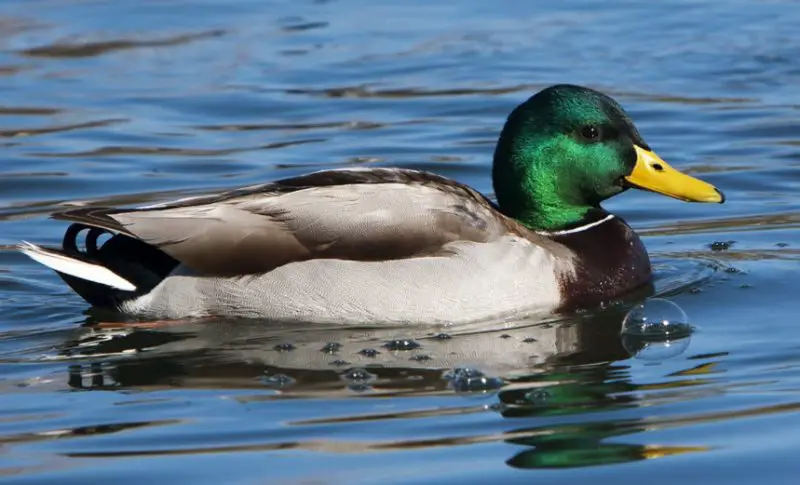
The Mallard Duck is perhaps the most recognizable duck species in Connecticut. Males have a glossy green head, white neck ring, chestnut-brown chest, and gray body, while females are mottled brown with an orange bill. Both sexes have a blue speculum (wing patch) edged in white. They measure about 20 to 26 inches in length with a wingspan of 32 to 39 inches.
Their vocalizations include the classic “quack” from females, while males make softer, raspier calls. Mallards are dabbling ducks, meaning they feed by tipping forward in the water rather than diving. They eat aquatic plants, insects, and grains.
Mallards are common year-round in Connecticut and are found in wetlands, lakes, ponds, rivers, and even urban park fountains. They are highly adaptable and are often seen mingling with domestic ducks. During breeding season, they nest on the ground, often hidden in tall grass near water.
Wood Duck
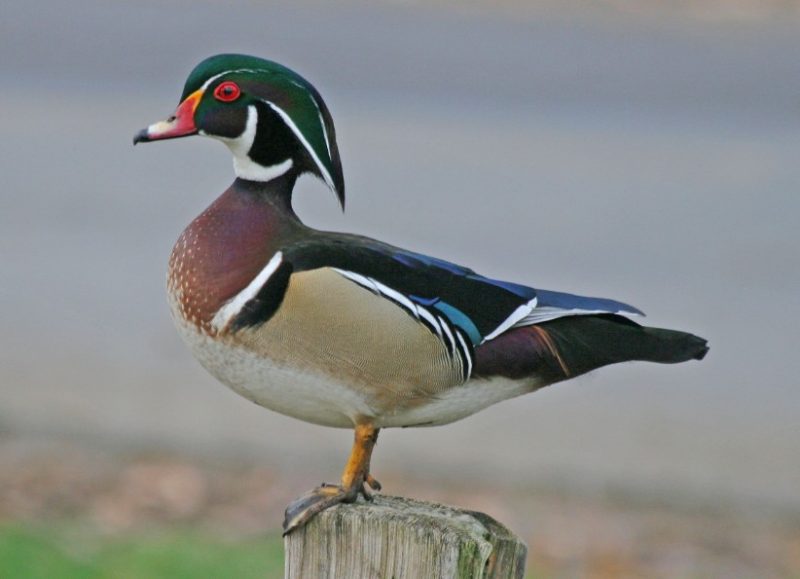
The Wood Duck is one of the most colorful and striking ducks in Connecticut. Males have iridescent green and purple heads with bold white stripes, red eyes, and a chestnut-colored chest, while females are grayish-brown with a white eye ring and subtle patterning. These medium-sized ducks are about 18.5 inches long with a wingspan of 26 to 29 inches.
Their call is a high-pitched, squeaky “oo-eek” from the female, while males give a soft, whistling “jeee.” Wood Ducks are strong fliers and skilled swimmers, often seen gliding through quiet woodland ponds. Unlike most ducks, they are cavity nesters, using tree holes or nest boxes to raise their young.
In Connecticut, Wood Ducks prefer wooded wetlands, swamps, beaver ponds, and slow-moving streams. They are present during the warmer months and migrate south in winter. Conservation efforts, including nest box programs, have helped maintain healthy populations in the state.
Snowy Egret
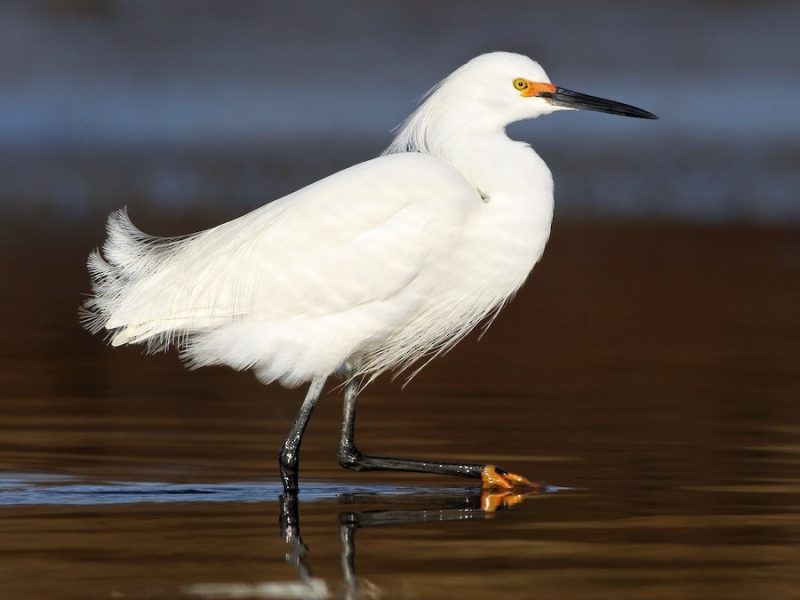
The Snowy Egret is a slender, elegant wading bird with pure white plumage, black legs, and striking yellow feet. It has a long, black bill and a graceful neck. Measuring around 24 to 27 inches in length with a wingspan of about 39 inches, it is slightly smaller than the Great Egret.
Its call is a harsh, raspy “squawk,” mostly heard in colonies or during flight. Snowy Egrets are active foragers, often using their bright yellow feet to stir up small fish or insects in shallow water. Their feeding style includes sudden darts, hops, and wing flaps as they chase prey.
In Connecticut, Snowy Egrets are summer residents found in salt marshes, estuaries, and tidal flats along the coast. They typically nest in colonies with other wading birds and migrate south in late fall. Their graceful presence makes them a favorite among birdwatchers.
Green Heron
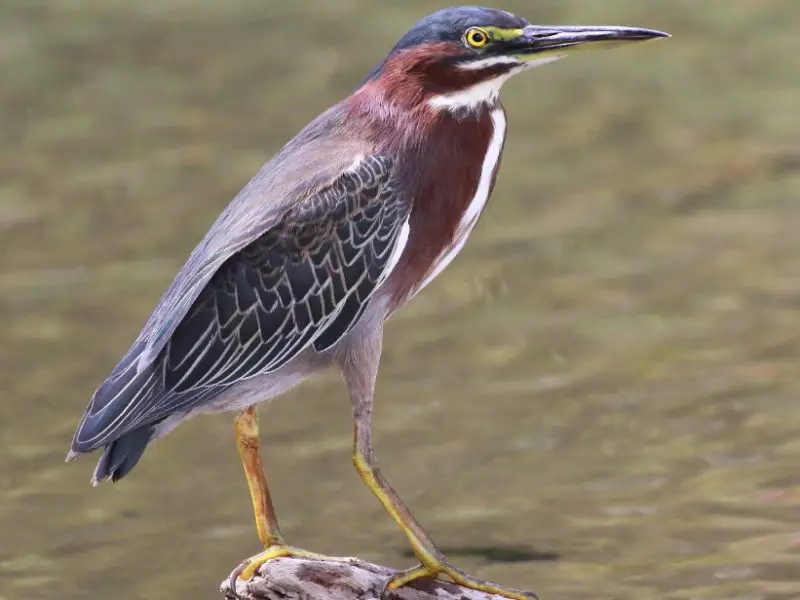
The Green Heron is a small, stocky heron with a dark, glossy green back, chestnut neck, and yellow legs. It has a sharp black bill and often appears hunched when perched. Adults measure about 16 to 18 inches long with a wingspan of 25 to 27 inches.
Its call is a loud, sharp “skeow,” often given when flushed. Unlike larger herons, the Green Heron often hides among dense vegetation and waits motionless for prey. It is one of the few birds known to use tools—dropping insects or twigs on the water to lure fish.
In Connecticut, Green Herons breed in secluded wetlands, wooded ponds, and along streams. They are most active at dawn and dusk and are typically seen perched low near water. They migrate south in fall and return to the state in spring.
American Black Duck
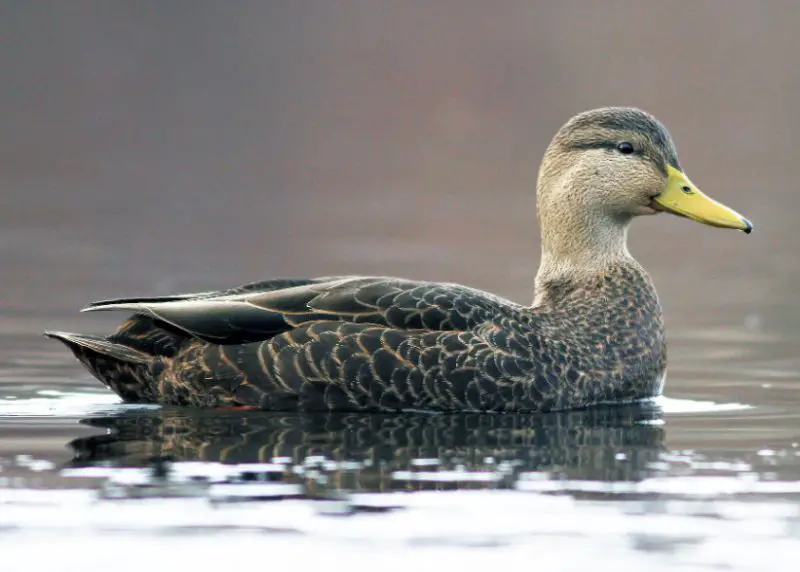
The American Black Duck is a large, dark dabbling duck with a dusky brown body and lighter face. It closely resembles a female Mallard but is darker overall. In flight, both sexes show a distinctive purple-blue wing patch bordered in black. It measures around 21 to 23 inches long with a wingspan of up to 35 inches.
Their vocalizations are similar to Mallards but quieter and huskier. Females give a raspy “quack,” while males produce a more subdued sound. These ducks are shy and prefer quiet, undisturbed wetlands, where they forage for aquatic vegetation and invertebrates.
In Connecticut, American Black Ducks are found in freshwater and brackish marshes, tidal estuaries, and coastal bays. They are present year-round, though numbers increase in winter due to migrants from farther north. They often associate with Mallards but are more reclusive by nature.
Ring-billed Gull
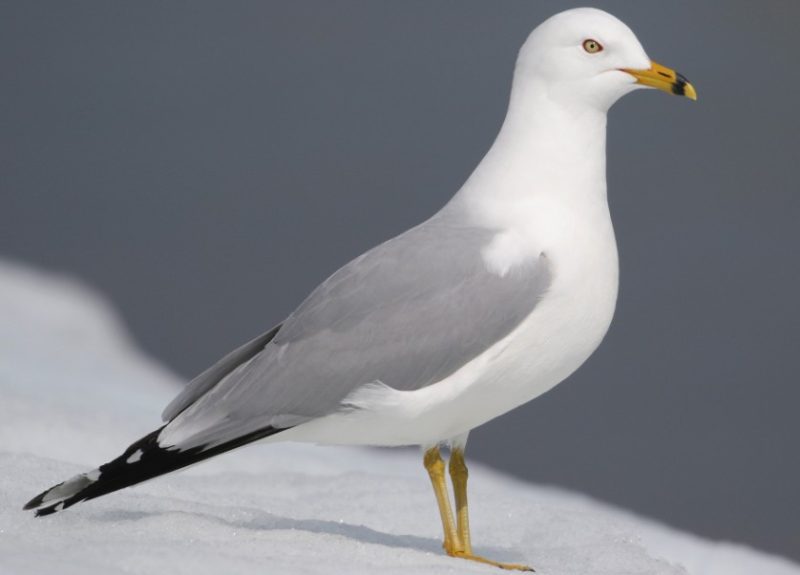
The Ring-billed Gull is a medium-sized gull with a white body, pale gray wings, yellow legs, and a yellow bill marked with a distinct black ring. Juveniles are mottled brown but gradually gain adult plumage over a few years. Adults measure about 17 to 21 inches long with a wingspan of 41 to 46 inches.
Their call is a high-pitched, laughing “kee-yaa” or “kleeer,” often repeated and heard in noisy flocks. Ring-billed Gulls are opportunistic feeders, scavenging in parking lots, beaches, fields, and near water. They feed on fish, insects, garbage, and even other birds’ eggs.
These gulls are widespread in Connecticut, especially near lakes, rivers, beaches, and landfills. They are most numerous in winter but can be found throughout the year. Their adaptability to human environments makes them one of the most commonly seen gulls in the state.
Raptors (Birds of Prey) in Connecticut
Red-tailed Hawk
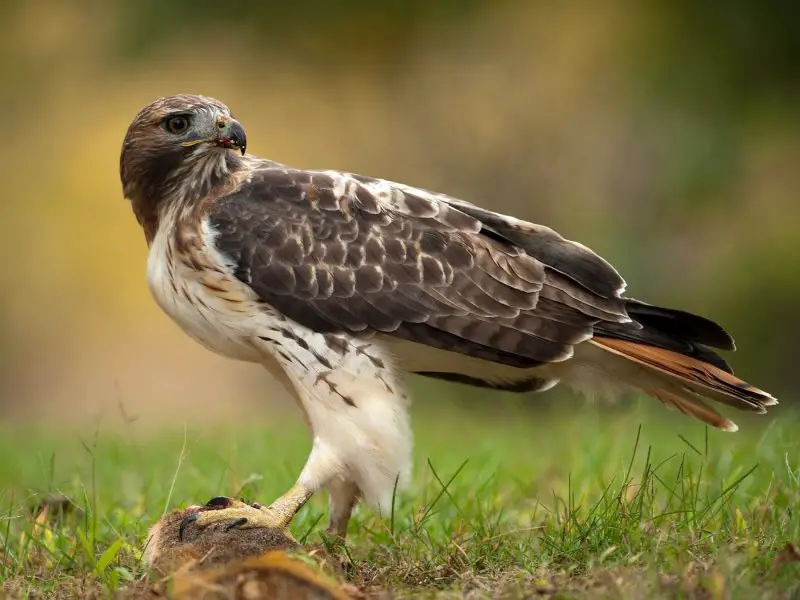
The Red-tailed Hawk is one of the most common and recognizable birds of prey in Connecticut. Adults have a broad, rounded wingspan of 45 to 52 inches and a body length of 18 to 26 inches. Their plumage is brown above and pale below with a streaked belly band, and mature birds have a rich, reddish-brown tail.
Its call is a loud, raspy “kee-eeeer,” often used in movies to represent any bird of prey. Red-tailed Hawks often soar in wide circles, using thermal currents, and are frequently seen perched on utility poles or tree branches along highways and open fields.
These hawks are year-round residents in Connecticut and adapt well to various habitats, including woodlands, farmlands, and suburban areas. They hunt mainly by sight and feed on small mammals like rodents, rabbits, and occasionally reptiles or birds.
Cooper’s Hawk
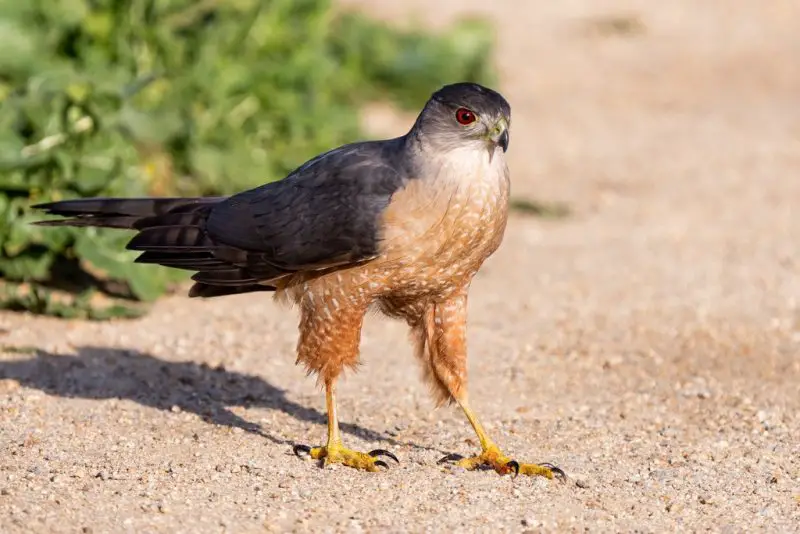
Cooper’s Hawk is a medium-sized, agile raptor known for its ability to navigate through dense forests. Adults are about 14 to 20 inches long with a wingspan of 24 to 35 inches. They have a blue-gray back, reddish-barred chest, and a long, rounded tail with dark bands.
Their call is a series of sharp, chattering “cak-cak-cak” sounds, usually heard during courtship or when disturbed. Cooper’s Hawks are swift and skilled hunters, often ambushing small birds at feeders or chasing prey through wooded areas with great speed.
In Connecticut, Cooper’s Hawks are seen year-round, especially in mature forests, suburban neighborhoods, and parks. They nest high in trees and have adapted well to urban life, taking advantage of backyard bird populations for food.
Bald Eagle
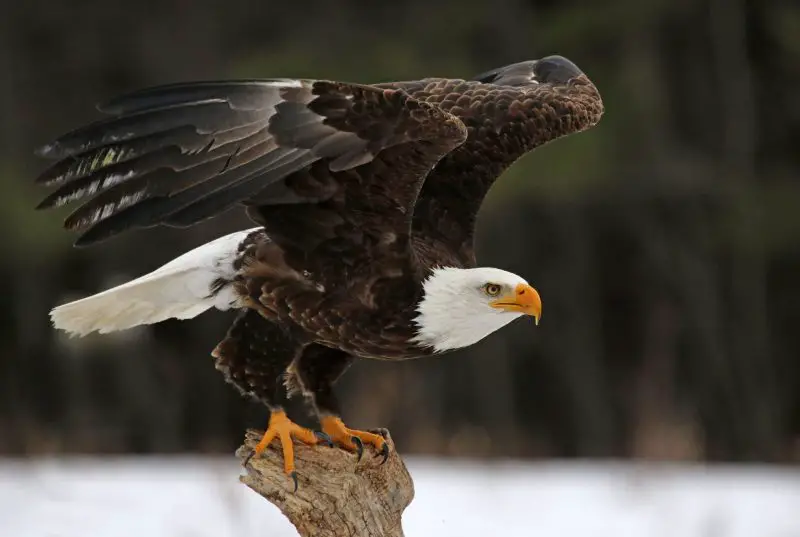
The Bald Eagle is a powerful and iconic bird, best known for its white head and tail contrasting with a dark brown body. Adults can measure 28 to 40 inches long with a wingspan of up to 7.5 feet. Juveniles are mottled brown and take several years to acquire adult plumage.
Its call is surprisingly weak for its size—a high-pitched series of whistling chirps, often mistaken for that of a smaller bird. Bald Eagles are expert fish hunters and are often seen gliding low over rivers and lakes or perched in tall trees near water.
In Connecticut, Bald Eagle populations have rebounded and are now observed year-round, especially near large rivers like the Connecticut River. They build massive nests in tall trees and often reuse them year after year, adding new material each season.
Osprey
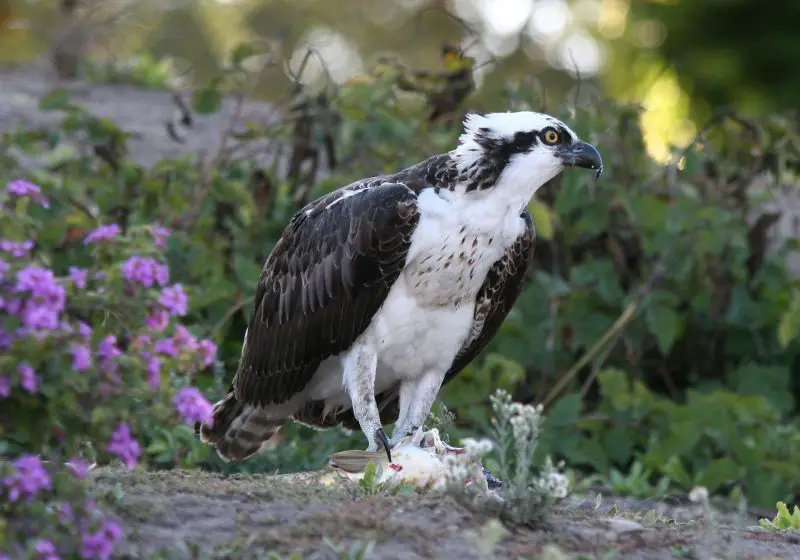
The Osprey is a large, fish-eating raptor with a wingspan of about 5 to 6 feet and a length of 21 to 23 inches. It has a white underbody, dark brown back, and a white head with a distinctive dark eye stripe. In flight, it shows a unique M-shape wing profile with long, narrow wings.
Its call is a series of short, high-pitched whistles, often heard near its nest or while flying. Ospreys are expert anglers, hovering over water before diving feet-first to catch fish with their sharp talons and barbed pads on their feet.
In Connecticut, Ospreys are common along the coast, rivers, and inland lakes during spring and summer. They migrate south in winter. They frequently nest on man-made platforms, utility poles, or dead trees near water, and their recovery has been a conservation success story.
American Kestrel
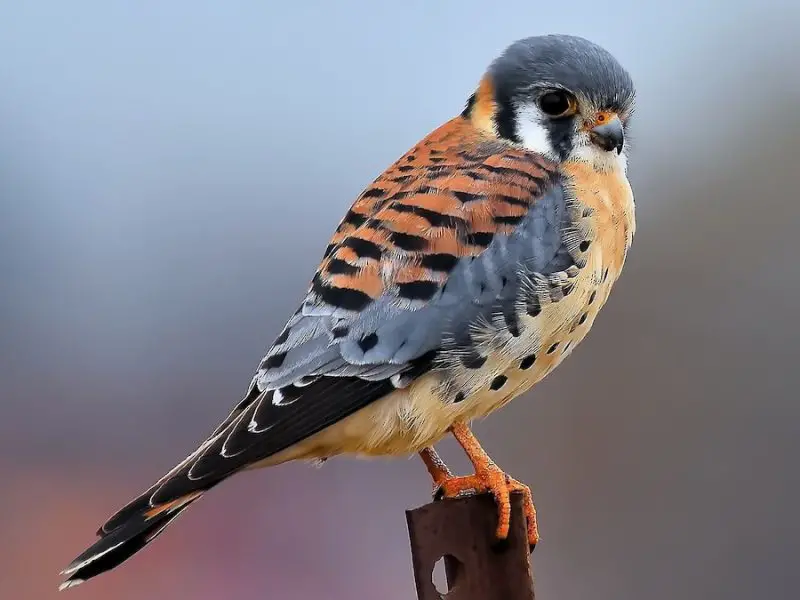
The American Kestrel is the smallest falcon in North America, measuring about 8 to 12 inches long with a wingspan of 20 to 24 inches. Males have blue-gray wings, a rusty back and tail, and black facial markings, while females are more uniformly brown and streaked.
Its call is a series of high-pitched “klee-klee-klee” notes. American Kestrels hunt by hovering over open fields or perching on wires and fence posts, searching for insects, small mammals, and birds. They are agile and often seen flicking their tails while perched.
In Connecticut, Kestrels are typically seen in open habitats such as farmlands, meadows, and grasslands during migration and breeding seasons. They nest in cavities, including nest boxes, and rely on open spaces for successful hunting. Their numbers have declined in some areas due to habitat loss.
Barred Owl
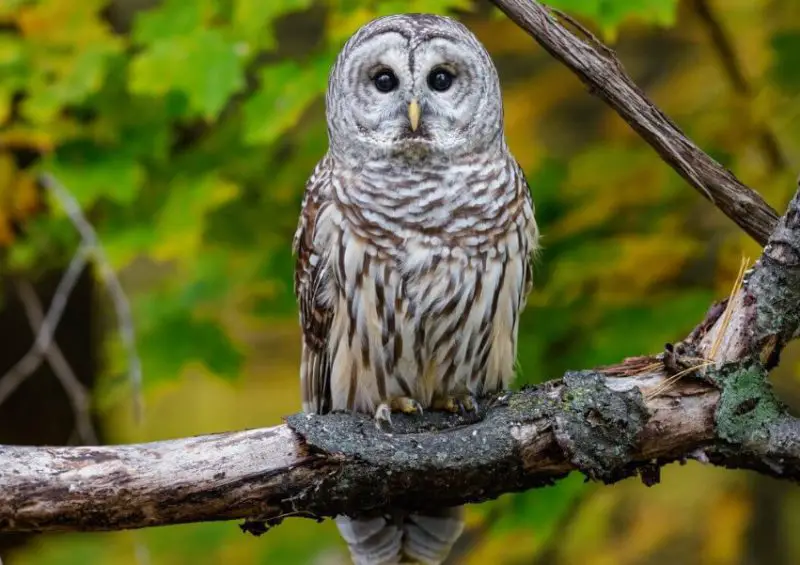
The Barred Owl is a large, round-headed owl with dark eyes and a mottled pattern of brown and white bars across its chest and belly. It measures about 16 to 25 inches long with a wingspan of 38 to 49 inches. It lacks ear tufts and has a pale facial disc bordered by dark rings.
Its distinctive call is often described as “Who cooks for you? Who cooks for you-all?”—a series of deep, hooting notes that echo through woodlands. Barred Owls are mostly nocturnal but can sometimes be active during the day, especially in overcast conditions.
In Connecticut, Barred Owls are year-round residents in mature forests, particularly near swamps, streams, and wooded wetlands. They nest in tree cavities and often stay in the same territory for years. They hunt small mammals, amphibians, and birds, often from low perches.
Eastern Screech-Owl
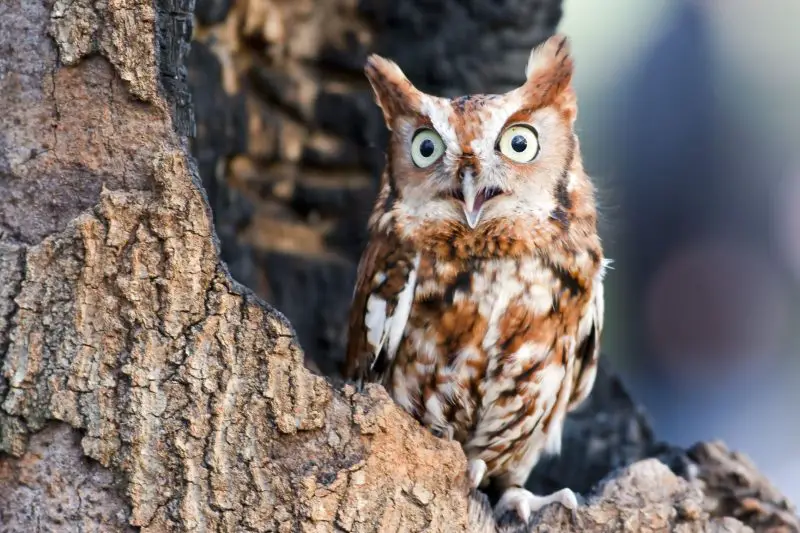
The Eastern Screech-Owl is a small owl with a compact body, ear tufts, and color morphs ranging from gray to reddish-brown. It stands about 6 to 10 inches tall with a wingspan of 18 to 24 inches. Despite its small size, it has a bold presence and blends well with tree bark.
Its vocalizations include a haunting, descending whinny and a soft trilling sound. It does not actually “screech” as its name implies. Eastern Screech-Owls are secretive and mostly active at night, often remaining motionless in tree cavities during the day.
In Connecticut, they are widespread in wooded areas, suburban neighborhoods, and city parks. They nest in natural tree holes or nest boxes and feed on insects, rodents, and small birds. Their cryptic plumage makes them difficult to spot, even when nearby.
Turkey Vulture
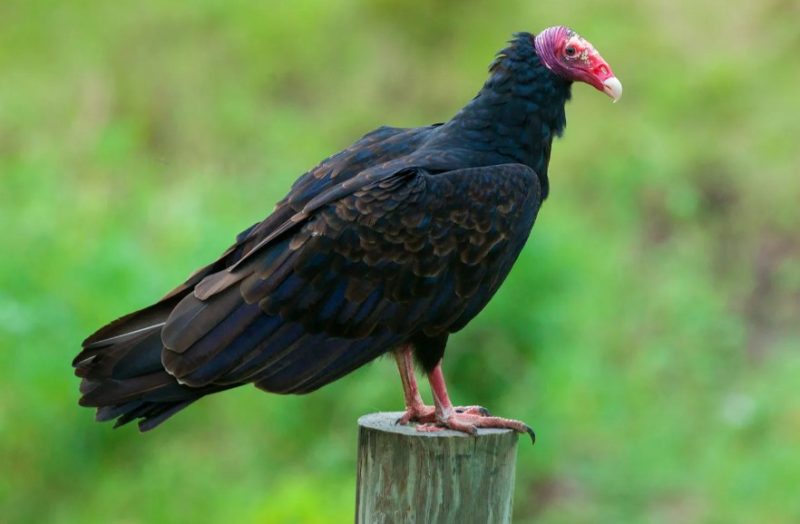
The Turkey Vulture is a large, dark scavenger with a red, unfeathered head, broad wings, and a two-toned underwing pattern—dark in front and light behind. It measures about 25 to 32 inches in length and has a wingspan of 5.5 to 6 feet.
It is generally silent but may hiss or grunt when disturbed. Turkey Vultures are known for their soaring flight, with wings held in a shallow “V” shape and frequent wobbling. They locate carrion by smell—a rare trait among birds.
In Connecticut, Turkey Vultures are common from spring through fall and are often seen gliding over highways, fields, and forests. They roost in large groups and may be seen perched on utility poles, dead trees, or barns. Most migrate south for the winter.
Northern Harrier
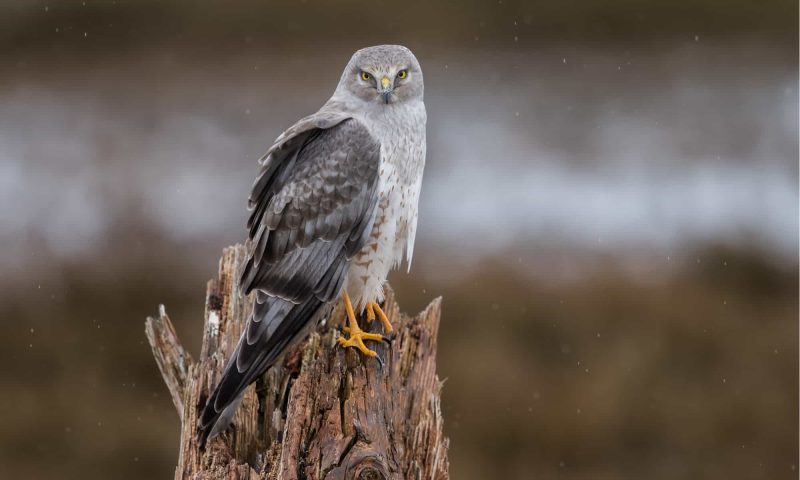
The Northern Harrier is a slim, long-winged raptor with a white rump patch that is easy to see in flight. Males are gray above with light underparts, while females and juveniles are brown. It measures about 16 to 20 inches long with a wingspan of 38 to 48 inches.
Its call is a high, chattering “kek-kek-kek,” mostly heard near nests. Harriers fly low over fields and marshes with wings held in a shallow “V” and often tilt side to side. They hunt by sight and sound, aided by an owl-like facial disc that helps direct sound to their ears.
In Connecticut, Northern Harriers are most commonly seen during migration and in winter. They favor open habitats like marshes, coastal grasslands, and fields. They nest on the ground and are often spotted gliding silently just above the vegetation.
Sharp-shinned Hawk
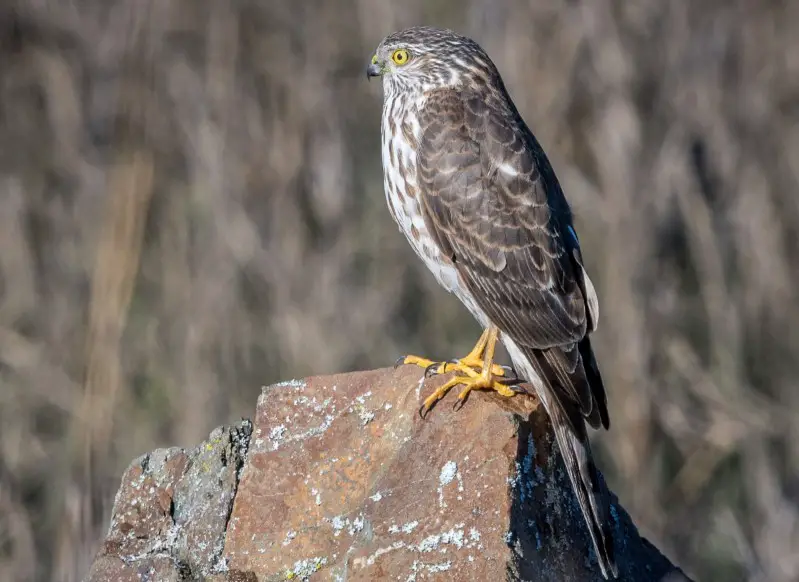
The Sharp-shinned Hawk is the smallest hawk in Connecticut, measuring about 9 to 13 inches long with a wingspan of 17 to 22 inches. It has short, rounded wings and a long, narrow tail with squared-off tips. Adults have blue-gray upperparts and reddish barring on the chest.
Its call is a rapid, high-pitched “kik-kik-kik,” often heard during breeding season. This hawk is a stealthy and agile flyer, darting through trees to catch small birds in flight. It often ambushes backyard feeder visitors during migration.
In Connecticut, Sharp-shinned Hawks are most commonly seen during spring and fall migrations, though a few may stay through winter. They prefer dense forests for nesting but can be seen in suburban areas when hunting. They are easily confused with the slightly larger Cooper’s Hawk.
Songbirds and Warblers in Connecticut
Eastern Bluebird
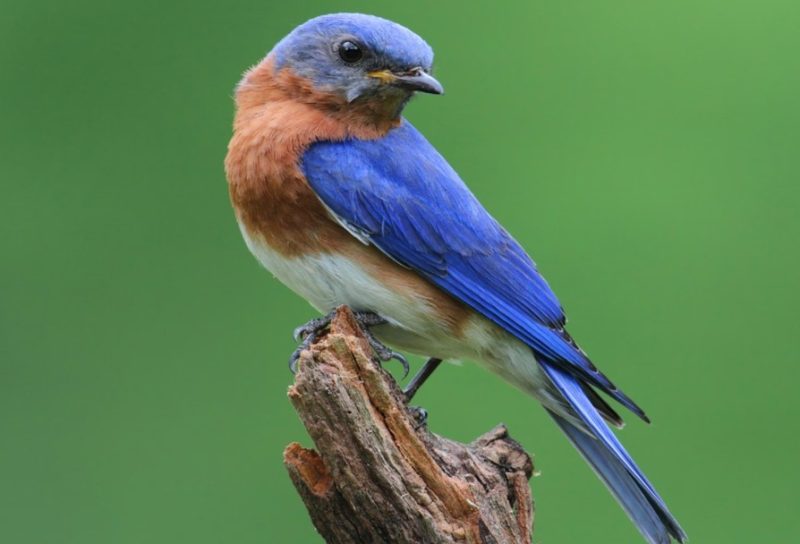
The Eastern Bluebird is a small, charming thrush with a bright blue back and head, a rusty orange chest, and a white belly. Females are duller in color but still show blue wings and tail. Measuring about 6.5 to 7 inches long with a wingspan of 9.8 to 12.6 inches, they are compact and delicate in appearance.
Their call is a soft, musical “cheer-cheerful-charmer,” and they also produce a variety of short whistles and warbles. Males sing to attract mates and defend nesting sites, often perching in the open. Bluebirds are insectivorous but also eat fruits and berries, especially in colder months.
In Connecticut, Eastern Bluebirds are found in open fields, orchards, and suburban areas with scattered trees and low ground cover. They often nest in cavities or nest boxes and can be seen year-round in milder parts of the state, especially where feeders and nest boxes are provided.
Carolina Wren
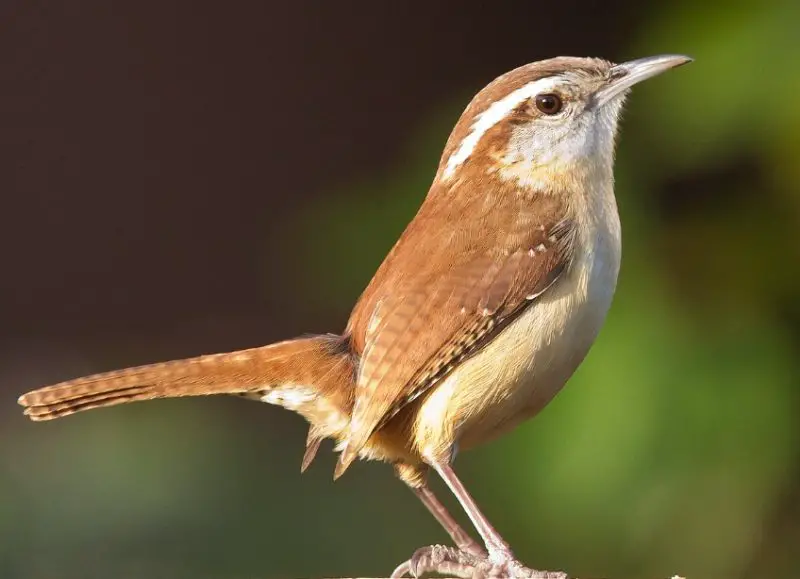
The Carolina Wren is a small, energetic bird with warm reddish-brown upperparts, a buffy belly, and a bold white eyebrow stripe. It has a slightly curved bill and a rounded body. It measures about 4.7 to 5.5 inches in length with a wingspan of 11 inches.
Its voice is loud and rich for its size, with songs like “teakettle-teakettle-teakettle” ringing through woods and yards. Carolina Wrens are vocal year-round, and both males and females give sharp calls and chatters. They are curious and often explore porches, garages, and woodpiles.
In Connecticut, these wrens are year-round residents, especially in southern and coastal areas. They prefer brushy woodlands, gardens, and suburban landscapes with dense vegetation. In winter, their numbers may decline during severe cold spells, but they often rebound quickly.
Song Sparrow
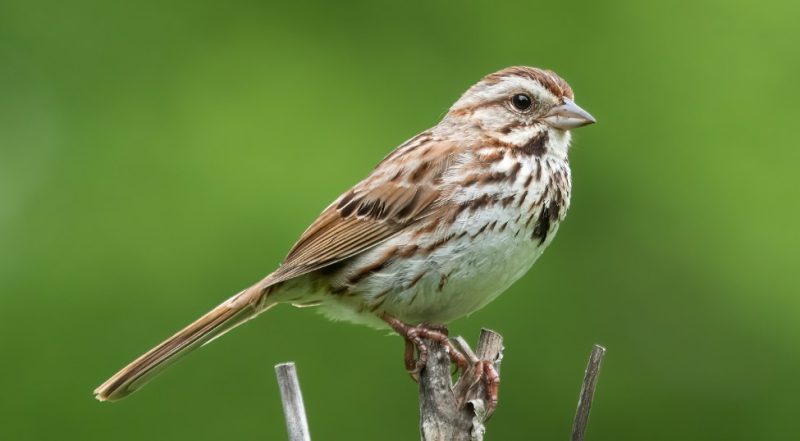
The Song Sparrow is a medium-sized, streaky brown sparrow with a rounded head, grayish face, and dark spot in the center of its chest. Its plumage varies somewhat across individuals, but it generally looks well-camouflaged. It measures about 5 to 7 inches long with a wingspan of 7 to 9 inches.
Its song is a cheerful mix of trills and buzzy notes, usually beginning with a few clear whistles. These sparrows sing frequently, especially from exposed perches like shrubs or fence posts. Their call is a sharp “chimp” or “tseep,” given during flight or as an alarm.
Song Sparrows are found throughout Connecticut in a variety of habitats—marshes, fields, forest edges, and residential areas. They are year-round residents in most of the state and build cup-shaped nests in low shrubs or grass. They forage mainly on the ground for seeds and insects.
Gray Catbird
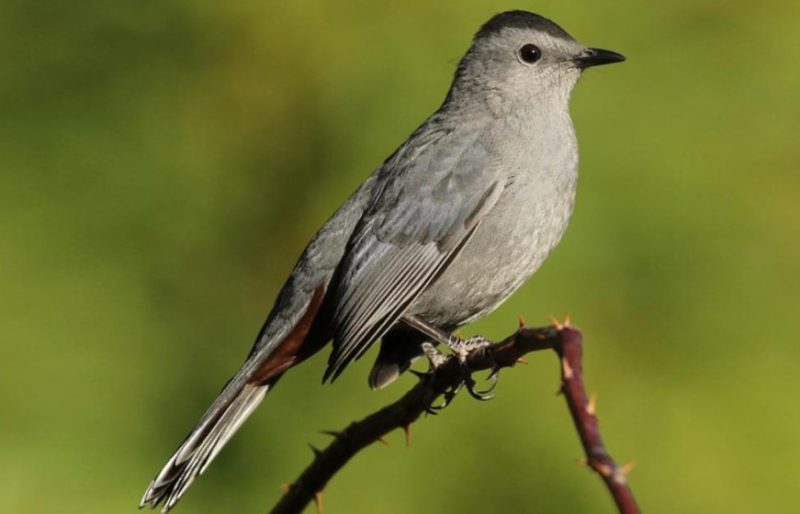
The Gray Catbird is a sleek, medium-sized songbird with slate-gray plumage, a black cap, and a rusty patch under the tail. It measures about 8.5 to 9.5 inches long with a wingspan of 8.7 to 11.8 inches. Its shape is slim, with a long tail and rounded wings.
Its call is a raspy “mew,” similar to a cat’s meow, which gives the bird its name. The Gray Catbird is an accomplished mimic and can string together long, complex phrases borrowed from other birds and environmental sounds. Males sing throughout spring and summer from hidden perches.
In Connecticut, Catbirds are common summer residents, especially in dense shrubs, thickets, and forest edges. They prefer areas with thick undergrowth for nesting. Most migrate south for winter, but they are among the first mimics to return in spring.
Northern Mockingbird
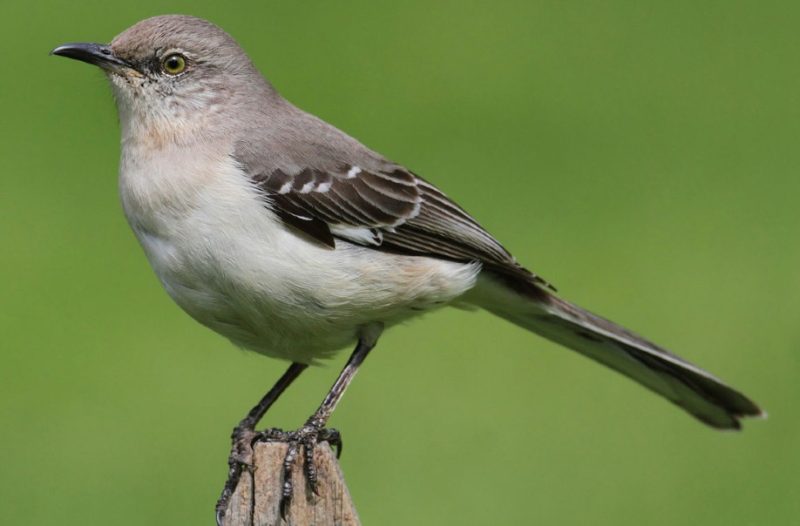
The Northern Mockingbird is a medium-sized songbird with gray upperparts, a pale underside, and distinct white wing patches that flash in flight. It has a long tail and a slender black bill. Adults measure about 8 to 10 inches long with a wingspan of 12 to 15 inches.
Its song is a long series of phrases repeated several times, often mimicking other birds, car alarms, or even cell phone tones. Mockingbirds sing day and night, especially during breeding season. They are highly territorial and will dive at intruders, including pets and people.
In Connecticut, Northern Mockingbirds are permanent residents, commonly found in urban areas, gardens, hedgerows, and open scrub. They often perch high on utility poles or treetops while singing. Their bold behavior and varied songs make them easy to recognize year-round.
Common Yellowthroat
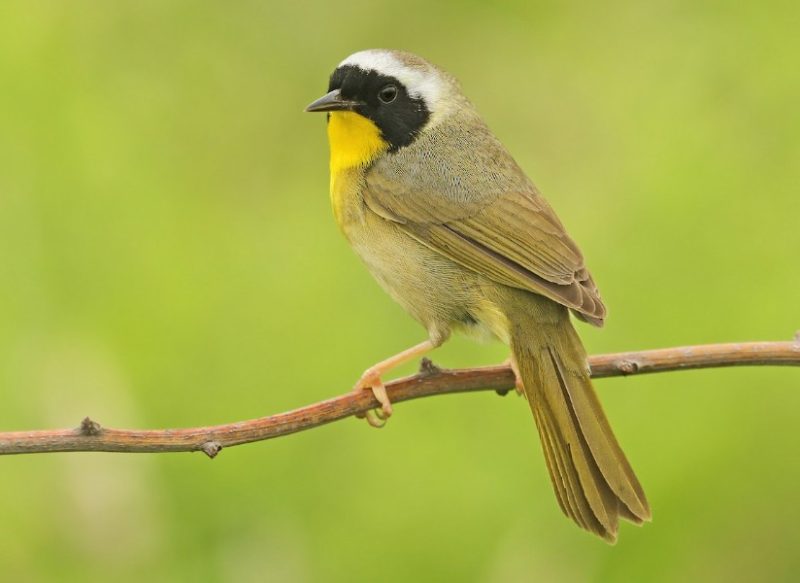
The Common Yellowthroat is a small, energetic warbler with olive-green upperparts and a bright yellow throat and chest. Males are easily recognized by their black facial mask bordered with white, while females lack the mask and are more subtly colored. They measure about 4.3 to 5.1 inches long with a wingspan of 5.9 to 7.5 inches.
Their song is a distinctive “wichity-wichity-wichity,” delivered from low shrubs or tall grasses. Common Yellowthroats also give sharp “chack” calls when alarmed. They are active and often stay hidden in dense vegetation, making them easier to hear than see.
In Connecticut, Common Yellowthroats breed in wet meadows, marshes, and thickets near water. They are present from spring through fall and migrate south for the winter. Their preference for low, brushy cover makes them common in both rural wetlands and overgrown suburban edges.
Yellow Warbler
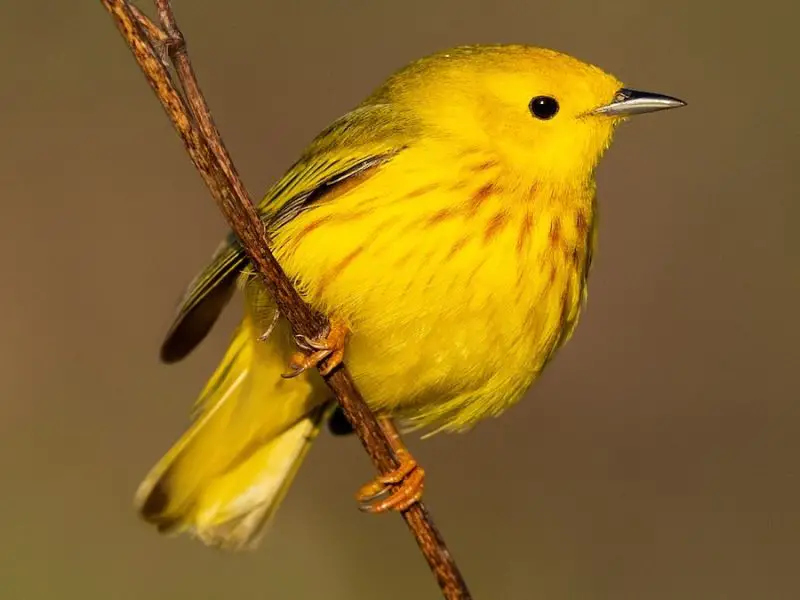
The Yellow Warbler is one of the most brightly colored warblers in Connecticut. Males are entirely yellow with fine reddish streaks on the chest, while females are a slightly duller yellow without the streaking. These small birds measure 4.7 to 5.1 inches in length with a wingspan of 6.3 to 7.9 inches.
Their cheerful song sounds like “sweet-sweet-sweet, I’m so sweet,” and is often repeated from treetops or shrubs. Yellow Warblers are active foragers, moving quickly through foliage in search of insects and caterpillars. They are often seen flitting through willows and wetland shrubs.
In Connecticut, Yellow Warblers are widespread during spring and summer, favoring stream edges, wetlands, and open areas with shrubs or small trees. They nest in low branches and migrate to Central and South America in the fall. Their vibrant color and simple song make them a favorite among birders.
Black-and-white Warbler
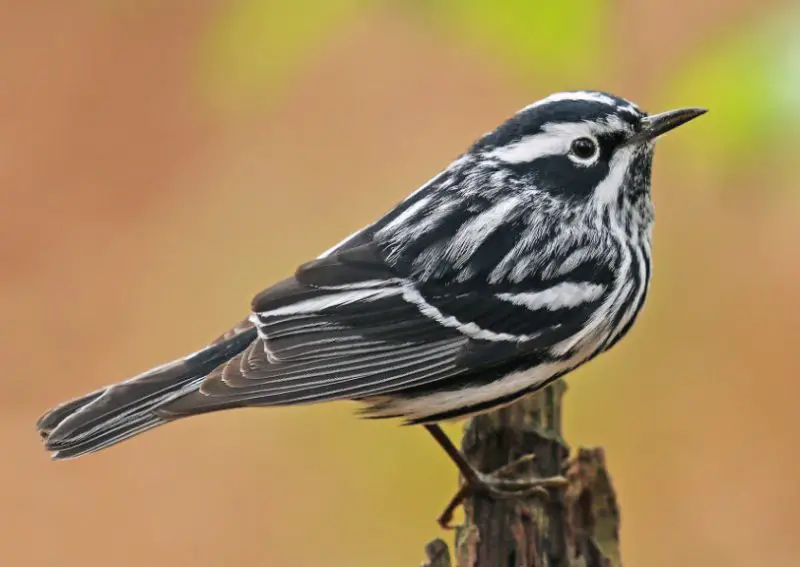
The Black-and-white Warbler is a unique warbler that resembles a miniature woodpecker in both appearance and behavior. It has bold black-and-white streaks across its body and face, with males having darker markings than females. It measures about 4.3 to 5.1 inches long with a wingspan of 7.1 to 8.7 inches.
Its song is a high, squeaky series of “wee-see, wee-see, wee-see,” and its call is a sharp “tick.” Unlike most warblers, it forages by creeping along tree trunks and branches, often spiraling upward in search of insects hidden in bark crevices.
In Connecticut, Black-and-white Warblers are commonly found in mature forests during the breeding season. They arrive in spring and leave by early fall. Their distinctive foraging style and contrasting plumage make them one of the easier warblers to identify in the field.
American Redstart
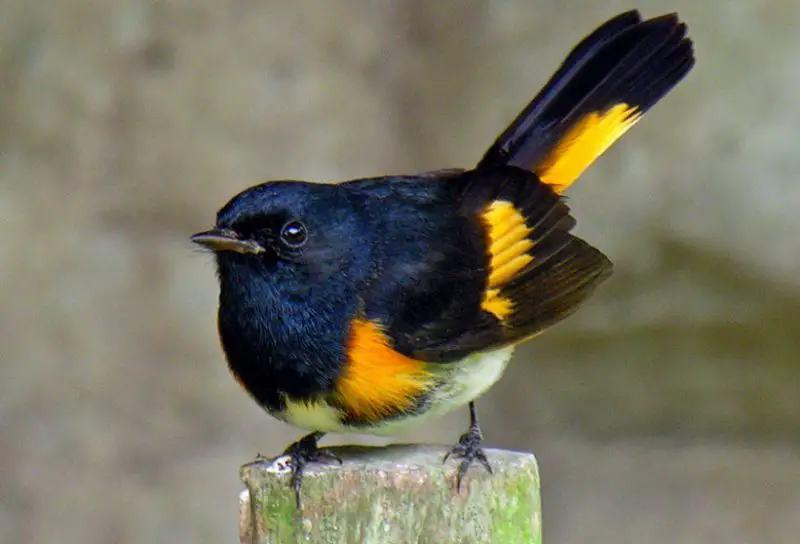
The American Redstart is a flashy, active warbler known for its bright plumage and restless movements. Males are mostly black with vivid orange patches on the wings, tail, and sides, while females are grayish with yellow patches. They are small, measuring about 4.3 to 5.1 inches long with a wingspan of 6.3 to 7.5 inches.
Its song is a variable series of high-pitched notes that often end in an accented phrase, and its call is a sharp “chip.” Redstarts fan their tails while foraging, flashing their colorful feathers to startle insects from foliage. They are quick and darting in their movements.
In Connecticut, American Redstarts are summer residents in woodlands, especially those with dense understory and near water. They nest in shrubs or low trees and migrate to the Caribbean and Central America for the winter. Their constant motion and striking coloration make them easy to spot in summer forests.
Pine Warbler
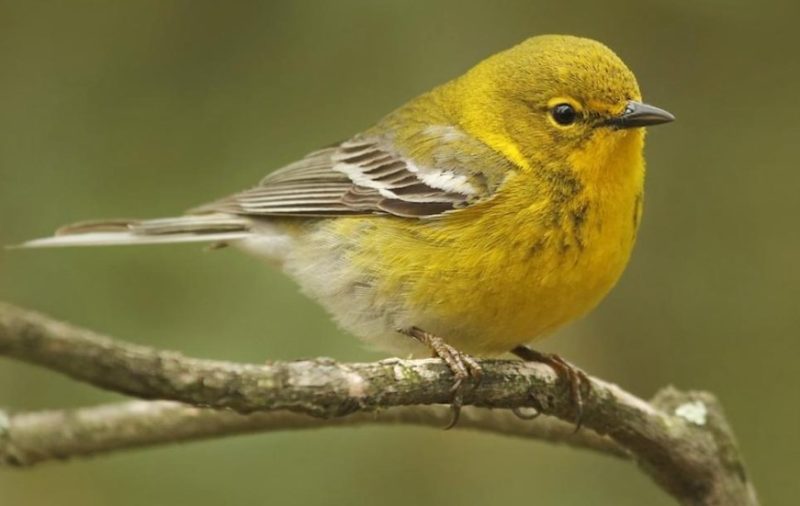
The Pine Warbler is a relatively chunky, yellow warbler with olive upperparts and faint streaks on the chest. Both males and females are yellow, but females and juveniles are often duller and more grayish. It measures about 5.1 to 5.5 inches long with a wingspan of 7.5 to 9.1 inches.
Its song is a simple, musical trill—dry and even-toned—resembling that of a Chipping Sparrow but softer and more melodic. Pine Warblers forage in the treetops but will also visit feeders, especially in cooler months, for suet and sunflower seeds.
In Connecticut, Pine Warblers are found in pine and mixed forests, especially during spring and summer. Some may remain in southern parts of the state year-round if food is available. Unlike many warblers, they are among the first to return in early spring and are one of the few to eat seeds regularly.
Woodpeckers in Connecticut
Pileated Woodpecker
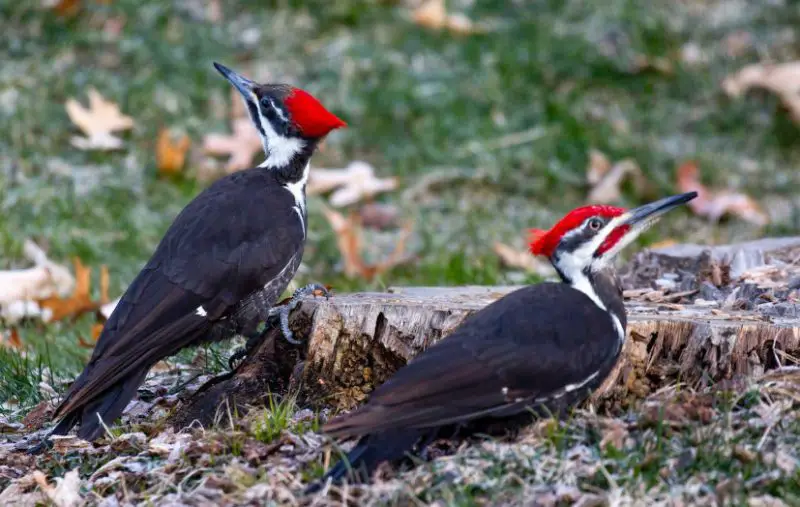
The Pileated Woodpecker is the largest woodpecker in Connecticut, easily identified by its crow-sized body, bold black-and-white coloration, and striking red crest. Males have a red stripe on the cheek, while females have a black stripe. It measures about 16 to 19 inches long with a wingspan of 26 to 30 inches.
Its call is a loud, echoing “kuk-kuk-kuk-kuk,” and it also gives sharp, ringing notes and deep drumming sounds. Pileated Woodpeckers excavate large rectangular holes in trees while foraging for carpenter ants and beetle larvae, leaving behind distinctive signs of their presence.
In Connecticut, they are permanent residents in mature forests with large standing dead trees. They can also be found in wooded suburbs and parks. Though elusive, their loud calls, powerful flight, and prominent holes make them relatively easy to detect once you know what to look for.
Hairy Woodpecker
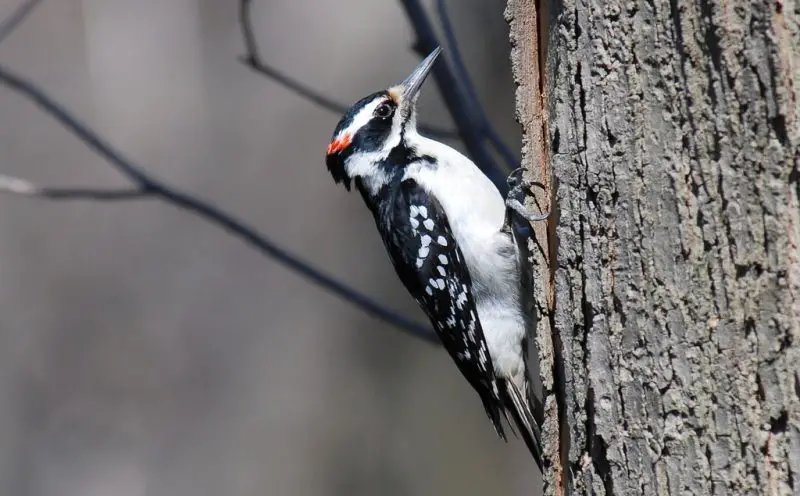
The Hairy Woodpecker is a medium-sized woodpecker with a black-and-white body and a white patch down the center of its back. Males have a small red patch on the back of the head. It is about 7 to 10 inches long with a wingspan of 13 to 16 inches, and it resembles the smaller Downy Woodpecker but with a longer bill.
Its call is a sharp, squeaky “peek,” and it also produces loud drumming on tree trunks. Hairy Woodpeckers feed mainly on insects, especially wood-boring beetles, and are often seen hitching up tree trunks or along thick branches.
In Connecticut, they are year-round residents found in mature forests, woodlots, and parks. They are less likely than Downy Woodpeckers to visit feeders but will come for suet in winter. Their preference for larger trees makes them more common in less disturbed woodlands.
Red-bellied Woodpecker
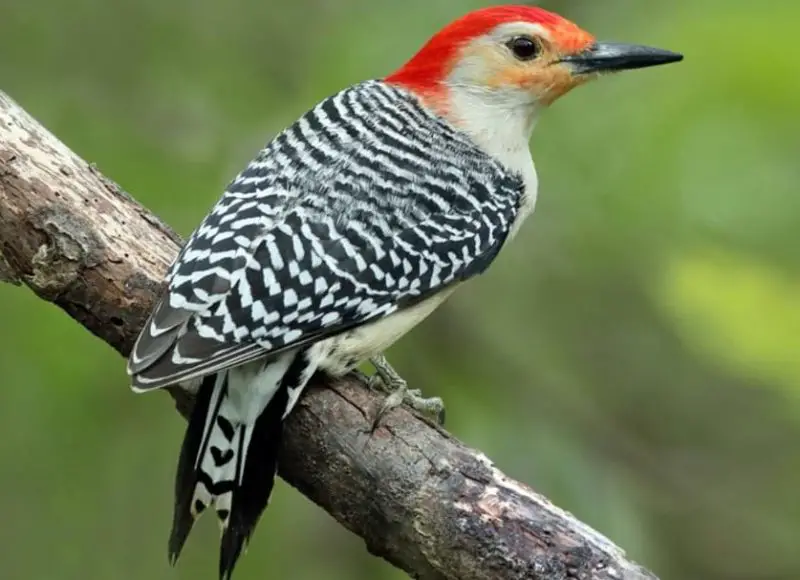
The Red-bellied Woodpecker is a medium-sized, striking bird with a pale body, black-and-white barred back, and red crown and nape in males (females lack red on the crown). Despite its name, the red on the belly is faint and often hard to see. It measures about 9 to 10.5 inches long with a wingspan of 13 to 17 inches.
Its call is a loud, rolling “churr” or “kwirr,” and it frequently vocalizes while flying or foraging. Red-bellied Woodpeckers have long tongues used to extract insects and also eat nuts, fruits, and seeds. They readily visit feeders and cache food in bark crevices.
In Connecticut, these woodpeckers are common year-round in woodlands, suburbs, and urban parks with mature trees. They are especially fond of oak forests and are regular visitors to suet feeders, often climbing vertically and probing tree trunks or branches.
Northern Flicker
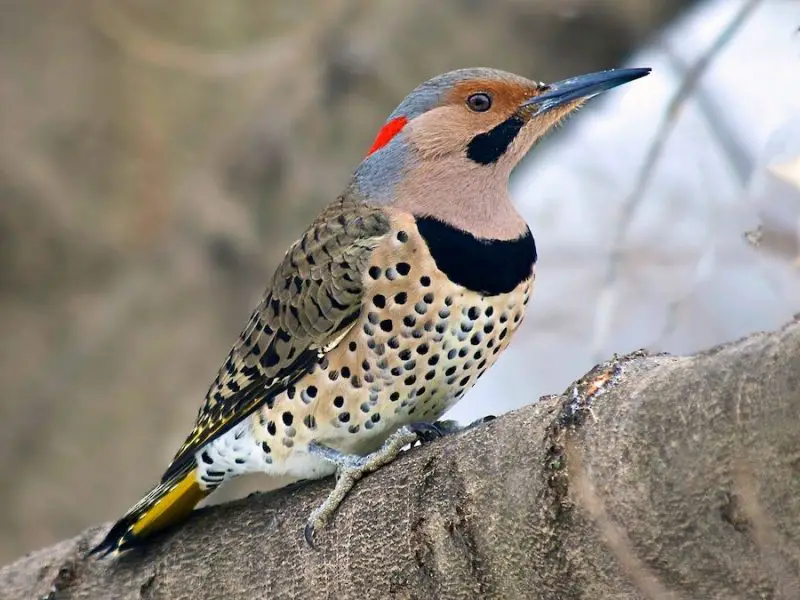
The Northern Flicker is a distinctive, ground-foraging woodpecker with a brownish body, black bars on the back, and a black chest crescent. Eastern birds have yellow underwings and undertails, giving them their nickname “Yellow-shafted Flicker.” They measure 11 to 12.5 inches in length with a wingspan of 17 to 21 inches.
Its call is a loud, ringing “kleer” and a series of repetitive “wicka-wicka” sounds. Flickers often drum on metal surfaces like gutters or poles. Unusually for woodpeckers, they spend a lot of time on the ground, using their long tongues to dig for ants—their favorite food.
In Connecticut, Northern Flickers are seen year-round, especially in open woodlands, forest edges, and suburban lawns. Some migrate south in winter, but many stay if the weather is mild. Their bouncing flight and bright yellow underwings are easy to spot in open areas.
Yellow-bellied Sapsucker
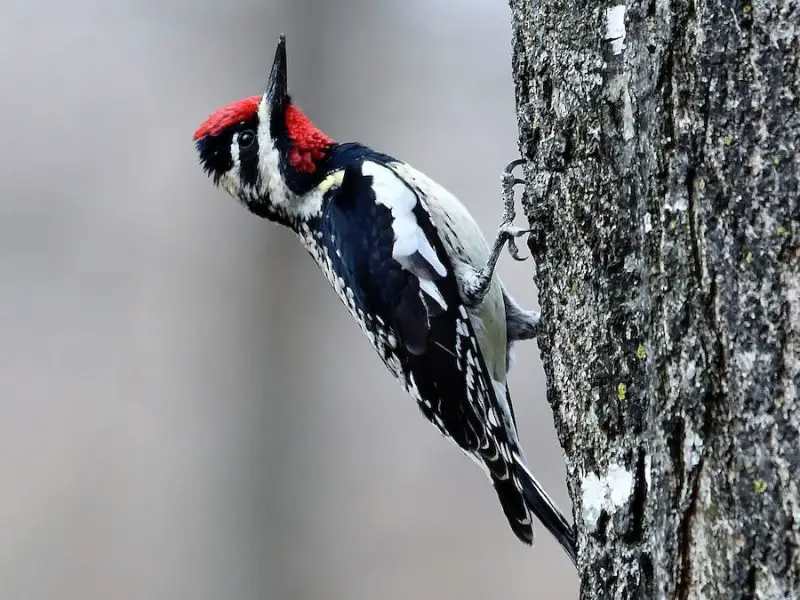
The Yellow-bellied Sapsucker is a medium-sized woodpecker with a black-and-white striped face, red crown, and pale yellowish belly. Males have a red throat, while females have a white throat. Adults measure about 7 to 9 inches long with a wingspan of 13 to 16 inches.
Its call is a nasal, cat-like “mew,” and its drumming is irregular, often starting slow and ending in a quick burst. Sapsuckers drill neat rows of holes in trees to feed on sap and the insects attracted to it. These holes are often revisited and maintained.
In Connecticut, Yellow-bellied Sapsuckers are breeding-season residents in the northern and higher elevation forests, and they pass through statewide during spring and fall migration. They prefer deciduous or mixed woodlands and are often found on birch, maple, or fruit trees.
Other Notable Birds in Connecticut
Wild Turkey
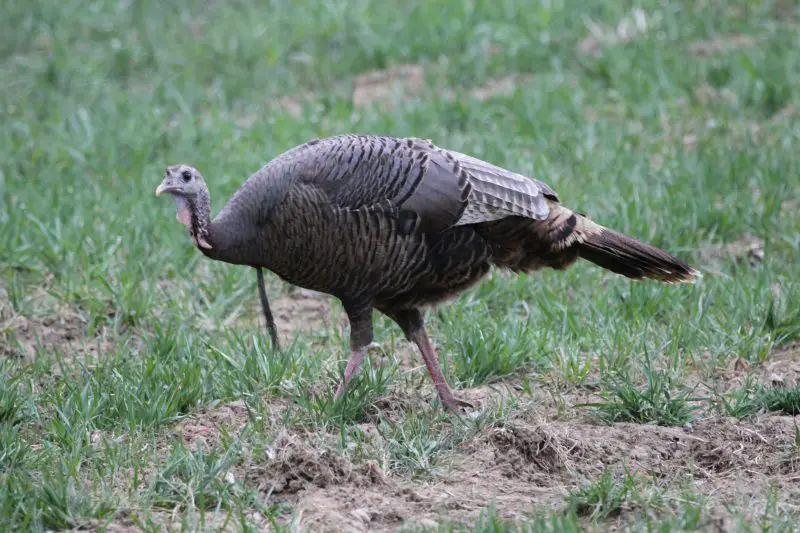
The Wild Turkey is a large, ground-dwelling bird with a dark, iridescent body and a fan-shaped tail. Males, called toms, display bright red wattles and a distinctive beard of coarse feathers on their chest. They measure about 3 to 4 feet in length with a wingspan reaching up to 5 feet.
Their gobbling call is loud and carries for long distances, especially during the breeding season. Wild Turkeys forage on the ground, feeding on seeds, insects, and small amphibians. They are strong fliers but usually prefer to run when disturbed.
In Connecticut, Wild Turkeys inhabit mature forests, farmlands, and open woodlands. They were once extirpated but have successfully rebounded due to conservation efforts. These birds are year-round residents and often seen in flocks, especially outside the breeding season.
Rock Pigeon
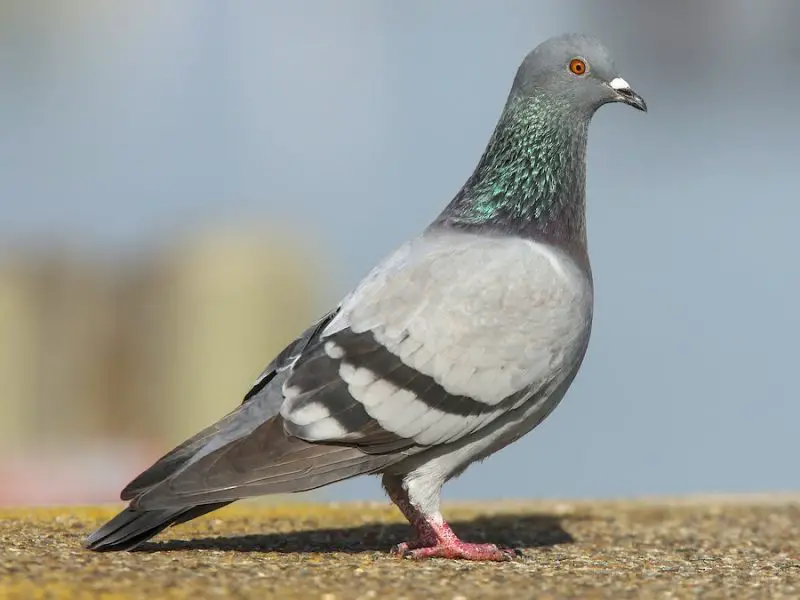
The Rock Pigeon is a common, adaptable bird with a stocky body, short neck, and slender bill. Their plumage varies widely, but most have gray bodies with iridescent green and purple neck feathers. They measure about 11 to 14 inches long with a wingspan of 20 to 26 inches.
Their cooing calls are soft and repetitive, often heard in urban and suburban areas. Rock Pigeons are highly social and often flock in large groups. They feed primarily on seeds and crumbs found near human habitation.
In Connecticut, Rock Pigeons are ubiquitous in cities, towns, and farms. They nest on building ledges, bridges, and other structures, thriving in human-altered environments. They are present year-round and often scavenge for food in public spaces.
Chimney Swift
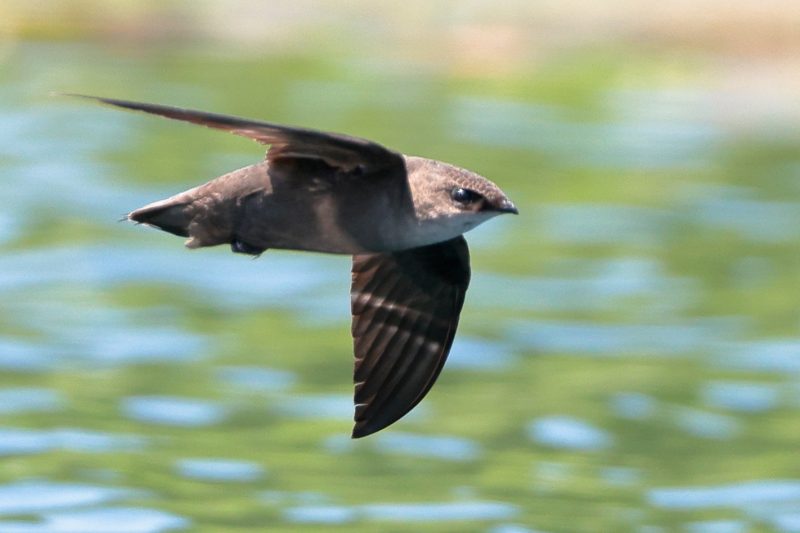
The Chimney Swift is a small, slender bird with long, narrow wings and a cigar-shaped body. It appears dark grayish-brown overall with a slightly paler throat. Adults measure about 4.5 inches long with a wingspan of 12 to 13 inches.
Their call is a high-pitched, rapid twittering or chattering heard during flight. Chimney Swifts are aerial insectivores, spending almost all their time flying as they catch insects on the wing. They are known for their rapid, erratic flight and often swirl in large groups at dusk.
In Connecticut, Chimney Swifts are summer residents that nest in chimneys, hollow trees, or old buildings. They arrive in late spring and migrate south in early fall. Their reliance on chimneys has made them vulnerable in some areas due to changing building designs.
Barn Swallow
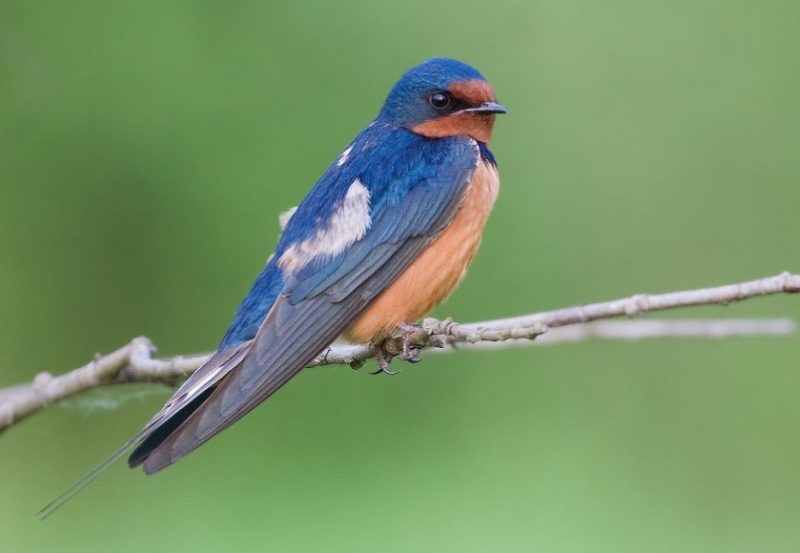
The Barn Swallow is a sleek, graceful bird with deep blue upperparts, a rufous throat and forehead, and a cream-colored belly. Its most distinctive feature is its long, deeply forked tail. Barn Swallows measure about 7 to 8 inches long with a wingspan of 11 to 13 inches.
Their song is a cheerful, warbling series of twitters and trills, often heard near human structures. They are skilled fliers and feed on flying insects, frequently seen swooping low over fields and water. Barn Swallows often perch on wires or fences between flights.
In Connecticut, Barn Swallows nest in barns, bridges, and other open structures from spring through fall. They build cup-shaped mud nests attached to vertical surfaces and migrate to Central and South America in winter. Their presence is closely tied to open, agricultural landscapes.
Purple Martin
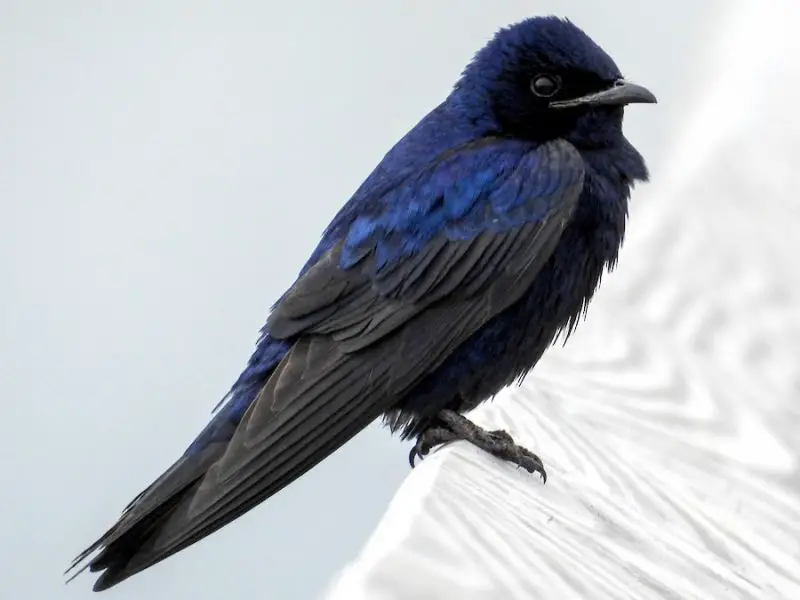
The Purple Martin is the largest swallow in Connecticut, with glossy, iridescent blue-black plumage in males and duller grayish tones in females. They have a stout body and a slightly forked tail. Adults measure about 7 to 8 inches long with a wingspan of 12 to 16 inches.
Their calls are varied and include chirps, gurgles, and warbles, often heard near communal nesting colonies. Purple Martins are highly social birds that nest in large groups in man-made birdhouses or natural cavities. They catch insects on the wing with agile, acrobatic flight.
In Connecticut, Purple Martins arrive in late spring and depend heavily on housing provided by people, often in suburban or rural yards. They breed here through summer and migrate to South America in winter. Conservation efforts include maintaining and monitoring martin houses to support populations.

